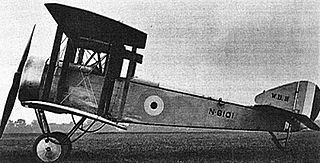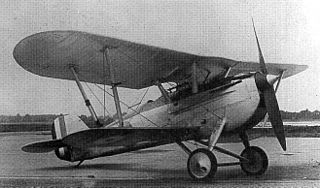
The Fairey Fox was a British light bomber and fighter biplane of the 1920s and 1930s. It was originally produced in Britain for the RAF, but continued in production and use in Belgium long after it was retired in Britain.

The Fairey Aviation Company Fairey III was a family of British reconnaissance biplanes that enjoyed a very long production and service history in both landplane and seaplane variants. First flying on 14 September 1917, examples were still in use during the Second World War.

Between 1911 and 1914, the Royal Aircraft Factory used the F.E.2 designation for three quite different aircraft that shared only a common "Farman" pusher biplane layout.

The Fokker F.V was a Dutch airliner created by Fokker in the 1920s. The most interesting property of the F.V was that it could be configured either as a biplane or a monoplane, as the lower wing could be removed. It was not a success and only one was built.

The Hawker Horsley was a British single-engined biplane bomber of the 1920s. It was the last all-wooden aircraft built by Hawker Aircraft, and served as a medium day bomber and torpedo bomber with Britain's Royal Air Force between 1926 and 1935, as well as the navies of Greece and Denmark.

The Avro 549 Aldershot was a British single-engined heavy bomber aircraft built by Avro.

The Martinsyde G.100 "Elephant" and the G.102 were British fighter bomber aircraft of the First World War built by Martinsyde. The type gained the name "Elephant" from its relatively large size and lack of manoeuvrability. The G.102 differed from the G.100 only in having a more powerful engine.

The Beardmore WB.III was a British carrier-based fighter biplane of World War I. It was a development of the Sopwith Pup that Beardmore was then building under licence, but was specially adapted for shipboard use.

The Supermarine Sea King was a British single-seat amphibious biplane fighter designed by Supermarine in 1919. Developed from the Supermarine Baby and the Supermarine Sea Lion I, the Sea King was a single seater biplane powered by a pusher 160 horsepower (120 kW) Beardmore engine. It first flew in early 1920 and was exhibited by Supermarine at the 1920 Olympia Show in London. The company released drawings of the aircraft's design prior to the show; what it exhibited was probably a modified Supermarine Baby.

The Vickers F.B.14 was a British two-seat fighter/reconnaissance biplane designed and built by Vickers Limited. About 100 were built for the Royal Flying Corps but saw only limited use as it was designed for a larger engine which was not available when production commenced and it did not meet performance expectations.
The Beardmore W.B.IV was a British single-engine biplane ship-based fighter of World War I developed by Beardmore. Only one was built.

The Beardmore W.B.V was a prototype British single-engine shipborne biplane fighter of World War I developed by Beardmore. It was not successful, only two being completed.
The Beardmore W.B.VI was a British single-engined folding wing torpedo bomber biplane of World War I developed by Beardmore.
The Beardmore W.B.II was a British biplane fighter prototype of the 1910s.

Polikarpov DI-1, also known as 2I-N1, Russian: Поликарпов ДИ-1 (2И-Н1), was a prototype Soviet two-seat fighter designed during the 1920s. The sole prototype built crashed on its ninth flight, due to manufacturing defects, and the program was cancelled.

The Westland Wizard was Westland Aircraft's first attempt to produce a monoplane fighter. The project was privately funded and the prototype design was done in the spare time of the company's engineers. This all happened during 1926, with high-speed performance as the primary goal.

The Saunders A.10 was a private venture four-gun fighter. It was a single-seat, single-engined biplane with poor handling, later serving as a gun-testing aircraft.
The Sopwith Snapper was a prototype British fighter aircraft of the First World War. A single-engined biplane designed by the Sopwith Aviation Company to replace the Sopwith Snipe fighter, it first flew after the end of the war, but did not enter service owing to the failure of its engine, only three aircraft being built.
The Sage Type 2 was a prototype British two-seat fighter aircraft of the First World War. A single-engined biplane with an enclosed cabin for its crew, only a single example was built, as more advanced aircraft became available.

The Sopwith Swallow was a British parasol wing fighter aircraft of the First World War. A single example was built, but it saw no production, offering no performance advantages over contemporary biplanes.















